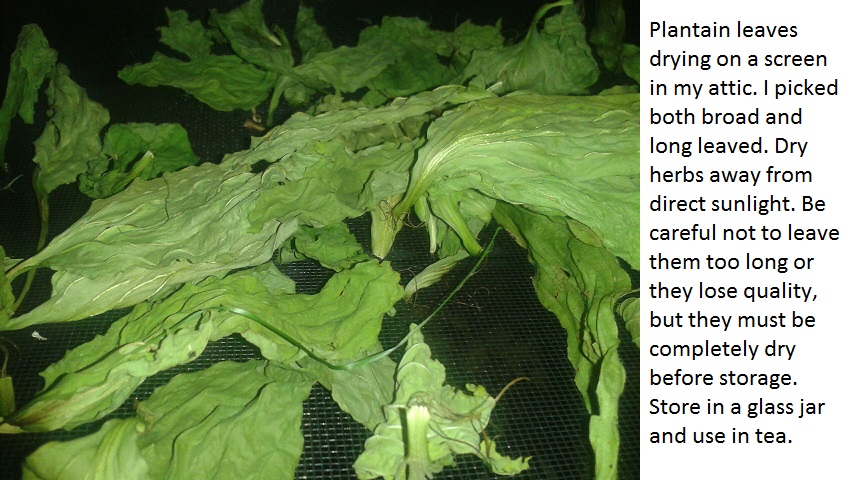Plantain~A Humble Plant With Big Medicine
Plantain-Broad Leaf Plantain(Plantago majus) Long or Lance Leaf Plantain (P. lanceolata)
Family:Plantaginaceae
Other names: Snakeweed, Whiteman's Foot, Round Leaf Plantain, Ripple Grass
Parts Used: Mostly the leaf but the seeds from Plantago psyllium raised commecially as a source of fiber and mucilage to be used as a laxative.
Qualities:astringent,decongestant,restorative, soothing diuretic, alterative, vulnerary, anti-inflammatory bitter, cold, dry and moist(it's mucilage moistens and soothes as it's astringency draws up),
Organ Affinity:Skin, Lungs, Intestines. Bladder, Kidney
Harvest: I've read in books to harvest in late Spring and early Summer, but have been taught that it was good to harvest anytime of year. Some herbalists say that the medicine is stronger after a couple of frosts in the Fall. I haven't expirimented with this yet, but I have used it in all seasons with success
Doctrine of Signatures: snakebite signature with the flower head appearing snake like. The parallel veins of the leaves indicate nervous system as it is used to reduce sensitivity to pain
Planet Ruler: Venus
Meridians: Lung, Large intestine, Bladder
Ayurveda: decreases Pitta and Kapha, increases Vata
Plantain is one of the most common herbal remedies on the planet. It rivals Dandelion in its presence and continual persistence to grow as up close and personal with human communities as possible. Plantain is often the first plant you will see as you step out your front door. It grows in every backyard whether in the city or the country and it is fearless in the face of sidewalk cracks and side lots. This plant is one of the greatest medicines on Earth and is often overlooked and actually weeded out of yards and gardens.
Plantain prefers full sun meadows, lawns and pathways. It has been called "whiteman's foot" by the First People because it came along with the settlers and grew in on the paths they walked. I was taught at one point that there is a Native species of plantain, but the only Native variety I have been able to identify based on text books is one woodland plant of the genus Carex; Carex plantaginea. Every indigenous herbalist I have asked has said that there is not a Native equivalent to our common plantain and that it was surely brought by the colonists.
Planta is latin for foot and Plantain grows best where the soil has been compacted. It has the ability to draw water and food from ground that has been walked on which is likely the same power it uses to so powerfully draw out toxins, pathogens and even splinters and glass from the human body. I was first introduced to Plantain as a remedy for stings, insect bites. cuts and scapes and it became a well used regular in our home remedy repetoire. This plant is simple and fun for children to use and, living in the country with four kids, we had lots of bug bites that they learned to immediately treat with plantain without hardly stopping their outdoor playtime. It would instantly reduce the pain and swelling while drawing out any venom, allergen or other irritant. It's name "snakeweed" was derived from its traditional use as a snake bite remedy used to draw the toxicity of the bite out and reduce the inflammation. To use for mosquito, wasp, black fly, bee and all other sorts of flying bug bites, simply pick a leaf, smush between your fingers or chew until the juice is expressed and place on the bite. We found it's drawing powers to even include glass and other splinters by smushing a leaf and attaching to the splinter with a band aid and leaving for several hours or overnight. Plantain will pull the foreign object right out.
Plantain is also used as an expectorant for coughs especially where there is "throat crud" that is just gurgling there but not being coughed up. To use this way I dry the leaves and make as a tea. It's astringent and drying properties help to pull and draw mucus up and out while its moistening properties soothe and repair the mucosa. An excellent remedy for laryngitis, any lung infection and even pneumonia.
The cooling propeties of Plantain will clear toxic heat and reduce inflammation as seen in allegies, eczema and even boils and abscesses. Matthew Wood has found Plantain to be particularly helpful in infections around the teeth where there may be abcess or root canal sepsis. He says " It is a specific here and it will almost never fail to draw out the pus and stop the infection, sometimes even saving the tooth where it was thought to be lost."
Plantain leaves can be identified not only by where they grow and their leaf shape, but by the clearly parallel veins that run up and down each leaf. This indicates an effect on the nervous system and so, Plantain is used for treating Bell's Palsy and Trigeminal neuralgia another painful condition of the face. It also reduces wound pain indicating it's ability to reduce nerve sensitivity. For neuralgia it is used internally as a tincture and can be used externally in a salve or oil to massage on the face or other affected area.
Plantain's many other attributes including an excellent nourishing diuretic that can be helpful in edema and kidney weakness. It tones the urinary system while resolving infection and astringing discharge helping to treat bladder infections. Plantaing will clear, cool, dry and soothe almost every area of the body. Lastly, it is considered an edible green and is steamed and eaten with other Spring greens. This invaluable plant is prolific and accessible to almost everyone. It literally grows under out feet!
Sources:
The Yoga of Herbs by Dr. David Frawley and Dr. Vasant Lad
The Essential Book of Herbal Medicine by Simon Y. Mills
The Earthwise Herbal by Matthew Wood
The Energetics of Western Herbs by Peter Holmes






